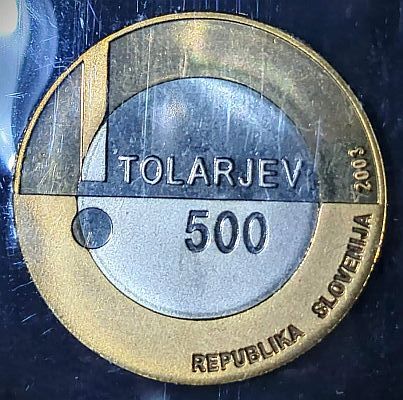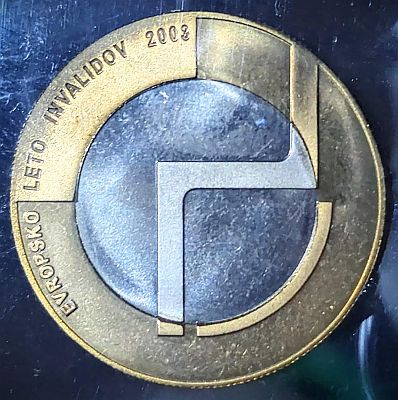An abstract design to mark the European Year of the Disabled

Slovenia
The Republic of Slovenia, in southern-Central Europe, is bordered by Italy, Austria, Hungary, Croatia and the Adriatic Sea. A mountainous country of 20,271 Km2 (7,827 Mi2), it has a population of 2.1 million. Inhabited since prehistoric times, a 60,000 year old bear bone flute was found in a cave in Slovenia. It is believed to be the oldest musical instrument ever found.
Currency
Formerly part of Yugoslavia, Slovenia gained independence in 1991. From 1991 until joining the Euro in 2006, Slovenia used the “Tolar” which was divided into 100 Stotinov. Standard circulating coins were issued in 10, 20 and 50 Stotinov, and 1, 2, 5, 10, 20 and 50 Tolarjev. Single-year circulating commemorative coins were issued, with the highest value being 500 Tolarjev in each year from 2002 – 2006. This commemorative coin is the 500 Tolarjev issued in 2003 for the European Year of People with Disabilities.
European Year of People with Disabilities
2003 was designated as the European Year of People with Disabilities. “The year will drive progress towards achieving equal rights for people with disabilities”. To commemorate that, this 500 Tolarjev was issued in 2003, with a mintage of 200,000, of which 1,000 were in sets. A further 1,800 were issued as proof coins in sets. The same design was used on 25,000 gold coins and 2,500 silver coins (neither for circulation).
Obverse
Banka Slovenije, the central bank of Slovenia issued a descriptive statement about the coins on their unveiling: “The simply designed commemorative coins “indicate the difficulty of being disabled, which may be overcome through respect of fundamental human rights. The front side of the coin bears an exclamation mark, which draws attention to discrimination against the disabled and promotes responsibility for an equality-based approach of healthy people to all disabled groups.”
Reverse

Banka Slovenije’s statement continues: “The motif of the exclamation mark is continued on the reverse side of the coin, where the upper part of a disabled person’s body is portrayed as an extension of a stylised wheelchair. The presentation of the disabled wheelchair, as the first image that reminds people of being disabled, leads to a consideration of physically challenged people and consequently to the establishing of such a social policy which respects the diversity of the disabled to the greatest possible extent. The circle, which like a globe embraces the central motif, draws attention to the international dimension of the disabled.”


Leave a Reply